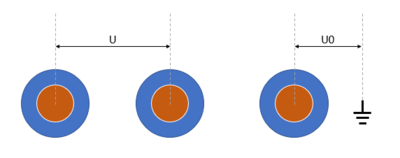Cable Voltage Grade
Definition
AC cables are designed to be suitable for specific design voltages, which is called the "Voltage Grade" (or "Voltage Designation", "Voltage Class" or "Voltage Rating") of the cable. The voltage grade is commonly expressed in the following form:
Where is the power frequency voltage between phase and earth (V rms)
- is the power frequency voltage between two phase conductors (V rms)
For example, some standard IEC voltage grades are 0.6/1kV, 1.9/3.3kV, 3.8/6.6kV, 6.35/11kV, 12.7/22kV, 19/33kV, etc.
For standard insulated cables, is always higher than because as shown in Figure 1, the measurement of is across two layers of insulation (one per phase conductor), whereas the measurement of is only across one layer of insulation to earth. Obviously, the voltage rating is higher the more insulation there is.
Some manufacturers design cables with voltage grades where , for example 1.0/1.0kV. In such cases, the rating can technically be higher, but the manufacturer has decided not to certify the cable for a higher voltage grade.
The manufacturer designs the cable (i.e. insulation, bedding, sheaths, etc) for the specified voltage grade. A cable can therefore be operated at voltages that do not exceed the voltage grade, e.g. a 0.6/1kV cable can be operated for any phase-to-earth and phase-to-phase voltages not exceeding 0.6kV and 1kV respectively. You may notice that LV cables are mainly specified to 0.6/1kV cables even though they are operated are much lower voltages (e.g. 240/415V, 220/380V, etc). This is due to the fact that the mechanical requirements of the insulation thickness are greater than the electrical requirements.
Neutral Earthing Considerations
For MV and HV cables (>1kV), some consideration must be given to the neutral earthing arrangements of the system when specifying a voltage grade. In the US, the Association of Edison Illuminating Companies (AEIC) has the following specifications depending on the neutral earthing arrangements and clearing time of the protective device:
- 100% insulation level
- 133% insulation level
- 173% insulation level
The insulation levels above refer to the nominal phase-to-phase voltages. For example, a cable with a 133% insulation level on a 33kV system is rated for 133% the nominal phase-to-phase system voltage, i.e. 133% x 33kV = 43.89kV.
100% Insulation Level
The 100% is the insulation level normally used for cables on solidly earthed systems, or on any system where the protective device will clear earth faults within 1 minute.
133% Insulation Level
The 133% insulation level is specified for systems where the protective device is expected to clear earth faults within 1 hour, and is typically specified for high impedance earthed or unearthed systems.
173% Insulation Level
The 173% insulation level is specified for systems where the time to clear an earth fault is indefinite. This is typically recommended for unearthed or resonant earthed systems.






